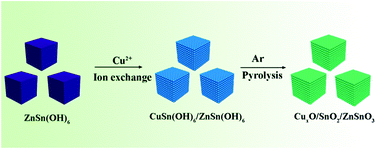当前位置:
X-MOL 学术
›
New J. Chem.
›
论文详情
Our official English website, www.x-mol.net, welcomes your
feedback! (Note: you will need to create a separate account there.)
Ion exchange for synthesis of porous CuxO/SnO2/ZnSnO3 microboxes as a high-performance lithium-ion battery anode†
New Journal of Chemistry ( IF 2.7 ) Pub Date : 2018-06-07 00:00:00 , DOI: 10.1039/c8nj02391c Min Zhang 1, 2, 3, 4, 5 , Jingjing Ma 1, 2, 3, 4, 5 , Yidan Zhang 6, 7, 8 , Leidan Lu 1, 2, 3, 4, 5 , Yaqin Chai 1, 2, 3, 4, 5 , Ruo Yuan 1, 2, 3, 4, 5 , Xia Yang 1, 2, 3, 4, 5
New Journal of Chemistry ( IF 2.7 ) Pub Date : 2018-06-07 00:00:00 , DOI: 10.1039/c8nj02391c Min Zhang 1, 2, 3, 4, 5 , Jingjing Ma 1, 2, 3, 4, 5 , Yidan Zhang 6, 7, 8 , Leidan Lu 1, 2, 3, 4, 5 , Yaqin Chai 1, 2, 3, 4, 5 , Ruo Yuan 1, 2, 3, 4, 5 , Xia Yang 1, 2, 3, 4, 5
Affiliation

|
Binary Sn-based metal oxides are potential anode materials for lithium ion batteries (LIBs). However, they suffer from large volume expansion during the discharge/charge process, leading to poor cycling performance. In this work, a multicomponent CuxO/SnO2/ZnSnO3 composite with a porous structure was prepared by employing ZnSn(OH)6 microcubes as precursors with the ion exchange method. Under high temperature, Cu2+ can exchange with partial Zn2+ in ZnSn(OH)6 to form CuSn(OH)6 microboxes. Then, through an annealing process, the porous CuxO/SnO2/ZnSnO3 composite was obtained, which also retained the box morphology. The CuxO/SnO2/ZnSnO3 microboxes can deliver an improved capacity of 615 mA h g−1 due to the porous structure, which may enhance the transportation of Li+ and electrons. The ion exchange method for obtaining porous binary metal oxide nanomaterials can be used for fabricating other metal oxide composites in many areas such as LIBs, catalysts, etc.
中文翻译:

离子交换法用于合成多孔Cu x O / SnO 2 / ZnSnO 3微箱,作为高性能锂离子电池阳极†
二元锡基金属氧化物是锂离子电池(LIB)的潜在阳极材料。然而,它们在放电/充电过程中遭受大体积膨胀的困扰,从而导致不良的循环性能。在这项工作中,通过使用ZnSn(OH)6微粒作为前驱体,通过离子交换法制备了具有多孔结构的多组分Cu x O / SnO 2 / ZnSnO 3复合材料。在高温下,Cu 2+可以与ZnSn(OH)6中的部分Zn 2+交换形成CuSn(OH)6微箱。然后,通过退火工艺,多孔Cu x O / SnO 2 / ZnSnO 3获得了复合材料,其还保留了箱形。由于具有多孔结构,Cu x O / SnO 2 / ZnSnO 3微箱可以提供更高的615 mA hg -1容量,这可以增强Li +和电子的传输。用于获得多孔二元金属氧化物纳米材料的离子交换方法可用于制造许多领域的其他金属氧化物复合材料,例如LIB,催化剂等。
更新日期:2018-06-07
中文翻译:

离子交换法用于合成多孔Cu x O / SnO 2 / ZnSnO 3微箱,作为高性能锂离子电池阳极†
二元锡基金属氧化物是锂离子电池(LIB)的潜在阳极材料。然而,它们在放电/充电过程中遭受大体积膨胀的困扰,从而导致不良的循环性能。在这项工作中,通过使用ZnSn(OH)6微粒作为前驱体,通过离子交换法制备了具有多孔结构的多组分Cu x O / SnO 2 / ZnSnO 3复合材料。在高温下,Cu 2+可以与ZnSn(OH)6中的部分Zn 2+交换形成CuSn(OH)6微箱。然后,通过退火工艺,多孔Cu x O / SnO 2 / ZnSnO 3获得了复合材料,其还保留了箱形。由于具有多孔结构,Cu x O / SnO 2 / ZnSnO 3微箱可以提供更高的615 mA hg -1容量,这可以增强Li +和电子的传输。用于获得多孔二元金属氧化物纳米材料的离子交换方法可用于制造许多领域的其他金属氧化物复合材料,例如LIB,催化剂等。











































 京公网安备 11010802027423号
京公网安备 11010802027423号